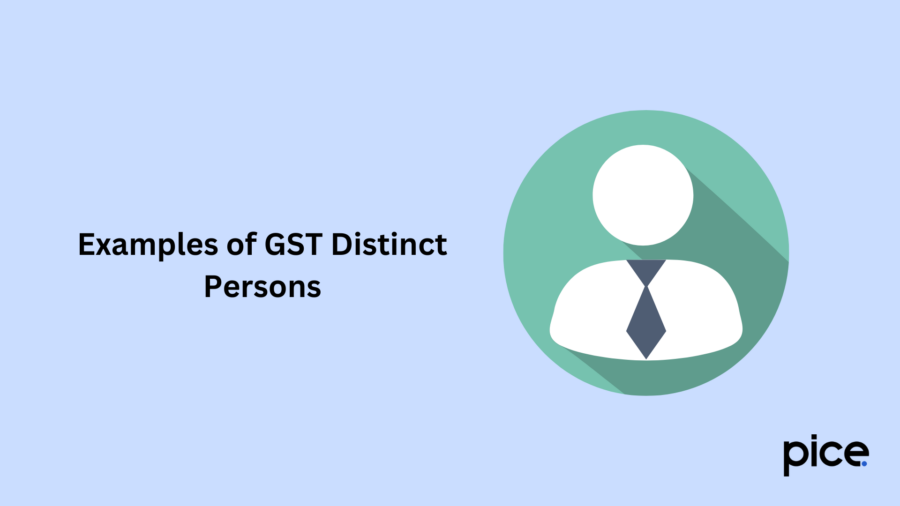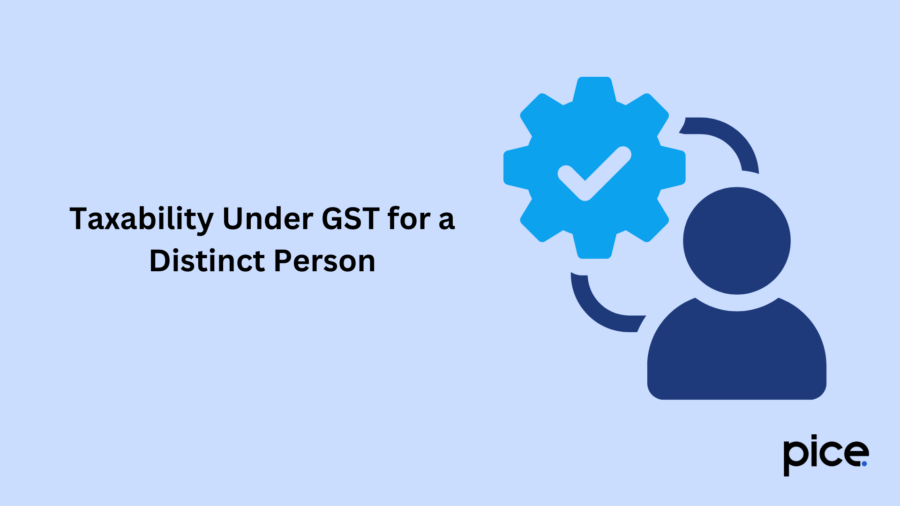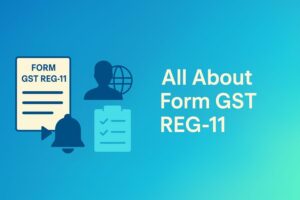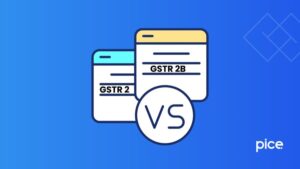Know about Distinct Person Under GST
- 31 Dec 24
- 11 mins

Know about Distinct Person Under GST
- Who Is a Distinct Person?
- GST Distinct Person Criteria: Understanding the Key Factors
- Examples of GST Distinct Persons
- Applying the GST Distinct Person Assessment
- Taxability Under GST for a Distinct Person
- Aԁvаntаges of Being а Distinсt Person for GST
- Embrасing GST Distinсt Person Stаtus for а Brighter Future
- Conclusion
Key Takeaways
- Distinct persons under GST are entities registered under the same PAN but in different states or verticals.
- Inter-branch transactions between distinct persons are taxable under GST law.
- Each GST registration enables independent input tax credit (ITC) claims.
- GST distinct person status simplifies multi-state tax compliance and filing.
- It promotes better tax planning, inventory management, and operational efficiency.
With the implementation of the Goods and Services Tax (GST) in India, businesses are introduced to a unified tax system. It is convenient due to specific rules and regulations while doing business transactions. The GST Distinct Person Test determines how many entities are recognised for Goods and Services Tax purposes. This difference affects inter-branch movement, input tax credits, and compliance mechanisms.
Keep scrolling to learn more about the GST Distinct Person Test and the situations in which it might be required.
Who Is a Distinct Person?

As per the law, any person with a valid PAN who has to register must do so in each state or union territory within 30 days of becoming liable. A person can apply for a single registration for all units within the same state.
As an exception, business verticals within a state can obtain multiple GST registrations if the business verticals involve different risks, returns, and functions from other components. Therefore, when two units of the same business obtain separate registrations, they will be treated as distinct entities/persons under GST law.
The laws regarding the filing of returns and other compliance procedures will apply separately to each. Generally, distinct persons can include:
- An establishment in India and an establishment outside India
- An establishment in one state or union territory and an establishment in another state or union territory
For example, if A (in Bangalore) has branches in Germany and Maharashtra, the branches will be considered distinct persons/entities. Similarly, if A has another component, B, which is distinct from A and has obtained a separate GST registration, A and B will also be distinct entities.
GST Distinct Person Criteria: Understanding the Key Factors
A distinct person is a registered person who determines the taxation treatment for transactions between entities under the same Permanent Account Number (PAN). This distinction gives a clear and precise understanding while applying the GST between states and union territories in India.
Here are the key factors that define the GST distinct person criteria:
Separate Legal Entity
Businesses must register for GST in all places where they conduct business operations. Under compliance procedures, the registration is separate from the natural body. Simply put, entities need to maintain legal identities, each with its own PAN or TIN, to qualify as a person.
Different Business Activities
The independence of operations is emphasized by conducting business or participating in marketplaces with separate registrations.
Distinct Units
An individual person's independence in transactions is highlighted by having their own financial accounts.
Arms Length Transactions
The arms-length concept must be followed in all transactions to guarantee business compliances, impartiality and fairness.
Physical Separation
Being physically situated in different areas emphasizes how independently enterprises with various sites may operate.
Specific Regulatory Obligations
To determine a person's status, compliance with tax, licensing and other regulatory obligations is essential.
Presence of Contracts
Contracts for the transactions of each entity demonstrate independence, adherence to business compliances, and alignment with the GST definition of distinct persons.
Ownership Structure
The case for being regarded as different individuals is supported by ownership structures that prohibit any entity from exercising control or retaining majority ownership.
Examples of GST Distinct Persons

The concept of distinct persons under the GST structure plays an important role in handling the transactions between two registered persons under the same PAN. The business vertical needs to get separate registrations. However, they have to be in different states or union territories.
Here are key scenarios that exemplify how distinct persons are treated under GST:
1. Franchise Networks between Two Different States
Suppose, a business entity functioning in Maharashtra and Gujarat having the same PAN number is needed to get two different GST registrations. If the Maharashtra branch supplies goods to the Gujarat branch after the GST law, they are considered to be supplied between two separate entities.
2. Branches of Multinational Corporations
Multinational corporations frequently set up branches in various countries, with each branch operating independently, adhering to local tax laws and keeping separate financial records. For instance, let us suppose there is a multinational corporation named XYZ Ltd with two branches, one in Tamil Nadu and the other in California. Although both branches are part of the same parent company, they are treated as separate entities for legal and taxation purposes.
3. Independent Contractors
Independent contractors working for clients are considered separate individuals or entities. They keep financial records, act autonomously, and make judgments. For instance, shifting stock from a warehouse situated in Tamil Nadu to another in Kerala needs proper invoicing and tax payment. This is irrespective of the fact that both firms have the same PAN number.
5. E-commerce Marketplaces
E-commerce sites and their vendors are regarded as business entities. Transactions are facilitated by the marketplace. It does not own the goods or set the prices.
6. Group Companies
If each subsidiary or group entity has its own legal identity and keeps separate financial records, the company may identify it as an entity.
Applying the GST Distinct Person Assessment
The GST Distinct Person Assessment is crucial for implementing GST in India uniformly. This test assures compliance, correct billing and accurate taxations that promote fairness in inter-state business transactions.
Steps to Apply the Test
Take the following actions to apply this test successfully:
- Recognise Relationships: Find out how the entities involved in your business activities are connected.
- Examine the Legal Structure: Examine your company's structure. Various structures, such as partnerships or subsidiaries, might influence how you are classified as a distinct business.
- Examine Financial Transactions: Check the financial transactions that take place between entities. This involves analyzing fund transfers, invoicing methods, and financial agreements like contracts or shared costs to clarify relationships and their dependencies.
- Evaluating Control and Decision Making: Examine the control and decision-making aspects of each involved entity. It is particularly important to monitor whether one entity exerts control or influence over another.
- Think About Sharing Resources: Be mindful of whether resources are being shared as assets or facilities. The sharing of resources may indicate a relationship between individuals.
- Check for Independent Activities: Determine whether entities engage in activities independently or rely on one another. Independence is a key factor in determining whether an individual is classified as a person.
- Look for Exрert Adviсe: If you have any doubts, you can consult with GST authorities or tax professionals for guidance and clarification about the classification of individuals.
Taxability Under GST for a Distinct Person

Supplies made between distinct persons are considered taxable and will be assessed based on the value determined under Rule 2 of the valuation rules. According to these rules, the value of the transaction is as follows:
- Supply's open market value
- In case open market value is unavailable, the value of the goods or services will be determined based on those of like kind and quality.
- If the open market value and value of like goods are unavailable, the value will be determined as 110% of the cost of production (Rule 4) or by the residual method (Rule 5)
- If the recipient is entitled to a full input tax credit, the invoice value for such transactions will be the open market value.
Aԁvаntаges of Being а Distinсt Person for GST
Here are some key benefits of being considered a distinct person for GST:
1. Enhanced Input Tax Credit (ITC) Benefits
One of the key benefits of being a specific entity under GST is the eligibility for ITC on taxes paid on goods or services consumed by an entity located in a particular state. Since each state is assigned a different GSTIN, the input tax credit can be claimed individually for each particular state concerned.
This system avoids any ambiguity on the issue of tax credits. It also makes it possible for each interstate or intra-state stock transfer to qualify for all the credits that it deserves. For instance, if a registered dealer having GST registration in Maharashtra and Tamil sells raw materials purchased in Maharashtra, the dealer in Maharashtra can recover the ITC paid for the GST incurred on these commodities.
2. Simplified and Streamlined Tax Compliance
This is an advantage for compliance with tax legislation, as each branch or office is considered to be a distinct person for GST. This enables one to handle the taxes for the company, which are filed and paid within different states separately.
Every GSTIN can file GSTR-1 and GSTR-3B returns and pay taxes separately for that state concerning the sales and purchases made within it.
3. Inter-State Supply and Transaction Clarity
It is essential to determine the clarity of inter-state supply and transactions between different states. The concept of distinct persons under GST helps us understand the appropriate approach for handling interstate transactions. It guarantees that the right amount of GST is recovered on such transfers at the time of supply.
4. Effective Inventory and Resource Management
For any business having branches or divisions in several states, involvement offers legal certainty in terms of inventory and resources. Each state-level branch can easily perform inventory transfers between them, as they are distinct. It is easier for businesses to monitor the movement of goods and services and tax requirements. This is important when ordering goods, meeting customer’s needs, and using resources.
5. Strаtegiс Tаx Plаnning
As per GST rules being a distinct person helps optimise tax planning. It streamlines the business functions and income streams which gives rise to tax-saving opportunities. Strategic tax planning is possible with a distinct person status as per GST rules and regulations. Audit risks can be minimised as being a distinct person will ensure proper tax compliance.
8. Oрerаtionаl Autonomy
A business entity can operate as a separate entity with a GST-distinct person status. Businesses can set prices of their products and services as per the distinct person status and make independent decisions which will be beneficial for them. It will also help them to increase efficiency, which in turn allows them to focus on achieving business goals and objectives.
Embrасing GST Distinсt Person Stаtus for а Brighter Future
The recognition of the GST Distinct Person status is the path for simplifying processes and compliance with an organisation’s multi-state operations. Separate state-level registration enables businesses to handle the tax implications effectively. It also allows them to claim the Input Tax Credit individually. Therefore, these regulations help in making inter-state sales easy.
This approach decreases the potential of penalties occurring during the supply of service. It helps to promote a far greater level of accountability in financial reporting. Implementation of this framework enables business organisations to centralise resource procurement. It will also improve inventory ordering and respond to regional market supply and demand conditions.
Conclusion
Overall, the concept of a distinct person under the GST law is complex yet crucial for cross-state businesses. It aids in complying with tax laws, managing input tax credits, and facilitating smooth transactions. Incorporation of such a framework helps organisations to remain compliant, relevant, and ready for long-run development in today's GST landscape.
💡If you want to streamline your payment and make GST payments, consider using the PICE App. Explore the PICE App today and take your business to new heights.
 By
By 

















